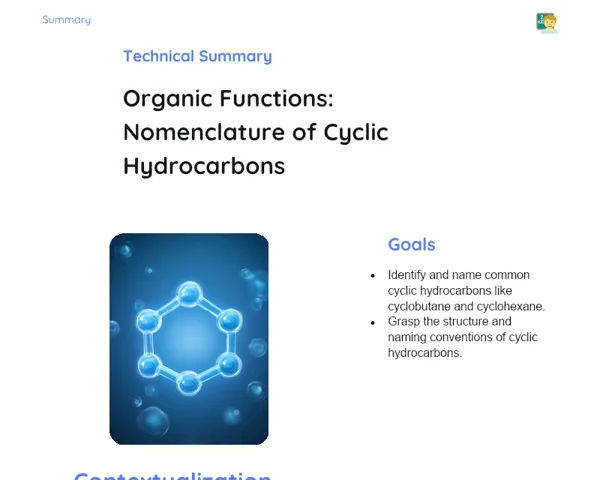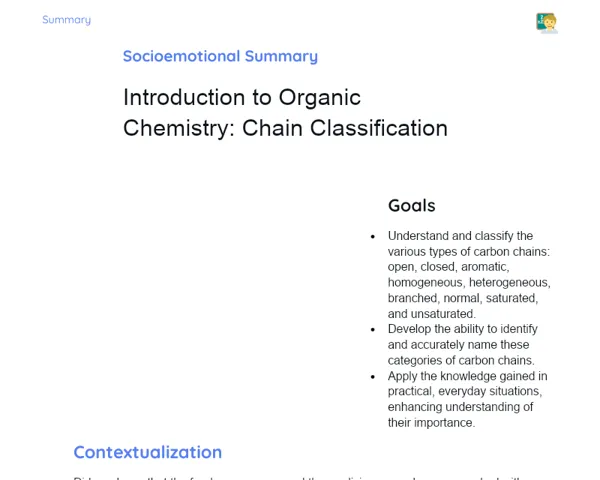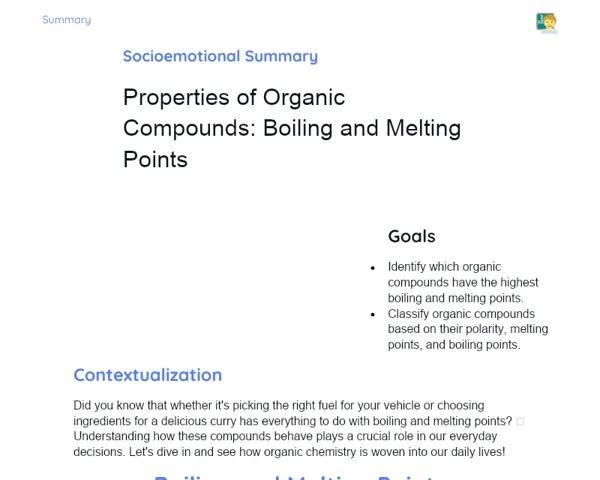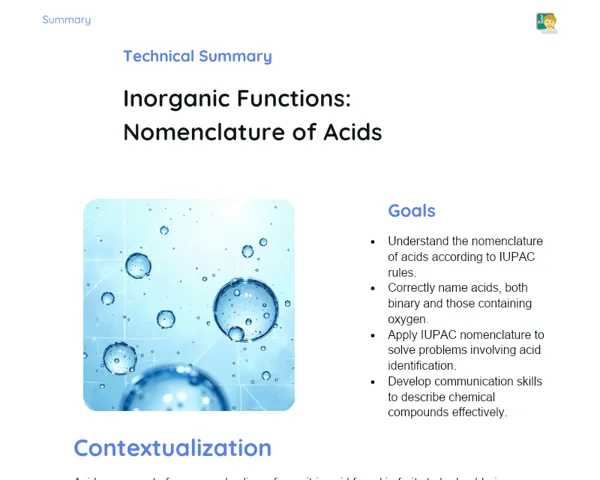Socioemotional Summary Conclusion
Goals
1. 🔬 Understand the key characteristics of nonmetals in the periodic table.
2. 📍 Identify the placement of nonmetals within the periodic table, including specific groups like halogens.
3. 🔄 Differentiate between nonmetals and metals based on their distinct properties and positions in the periodic table.
Contextualization
🌟 Did you know that nonmetals are vital components in chemistry, found everywhere around us? They not only play a significant role in chemical reactions but are also essential in various industrial applications. For instance, halogens like chlorine and fluorine are crucial for purifying drinking water and manufacturing medicines! 🧪 Grasping the importance of these elements extends beyond textbooks, enhancing our understanding of the world and the society we live in. 🌍
Exercising Your Knowledge
Definition of Nonmetals
Nonmetals are elements that lack typical metallic properties, such as luster or the ability to conduct heat and electricity well. Unlike metals, they tend to be brittle when solid, exhibit high electronegativity values, and have a strong tendency to attract and gain electrons.
-
Conductivity: Nonmetals are poor conductors of heat and electricity, making them unsuitable for use in electrical wiring or kitchen utensils that require heat dissipation.
-
Electronegativity: Due to their high electronegativity, nonmetals readily gain electrons during chemical reactions, directly affecting their reactivity.
-
Physical States: Nonmetals can exist in various physical forms at room temperature – solids (like carbon), liquids (like bromine), and gases (like oxygen).
Location in the Periodic Table
Nonmetals are mainly situated on the right side of the periodic table, with hydrogen positioned at the top of group 1. Understanding their location is key to predicting their chemical behavior and interactions with other elements.
-
Grouping: Most nonmetals are found in groups 14 to 18 (IVA to VIIIA) of the periodic table, facilitating the identification of common chemical behaviors.
-
Exception: Hydrogen serves as a unique nonmetal located at the beginning of group 1, distinguished by its own set of properties in comparison to the other elements in this group.
-
Reactivity Prediction: Knowledge of nonmetals' positions aids in anticipating the elements they are likely to react with, assisting in the synthesis of new substances.
Specific Types of Nonmetals - Halogens
Halogens constitute a distinct group of nonmetals, including fluorine, chlorine, bromine, iodine, and astatine. They are highly reactive and find extensive applications in industry and healthcare.
-
Reactivity: The high reactivity of halogens results from their strong electronegativity and inclination to gain an electron for stability.
-
Industrial Uses: Chlorine and fluorine are commonly employed in processes such as water purification and pharmaceutical manufacturing.
-
Safety: The extreme reactivity of halogens necessitates careful handling in laboratory and industrial settings.
Key Terms
-
Nonmetals: Elements that do not exhibit metallic properties.
-
Electronegativity: The capacity of an atom to attract electrons in a chemical bond.
-
Halogens: Nonmetals belonging to group 17 of the periodic table, noted for their high reactivity.
For Reflection
-
In what ways can the high reactivity of halogens represent both a challenge and an advantage in industrial and medical fields?
-
How does understanding the placement of nonmetals in the periodic table enhance our ability to predict their chemical interactions?
-
How can a solid grasp of nonmetal properties guide us toward responsible use of chemicals in our daily lives?
Important Conclusions
-
🌟 Nonmetals are critical elements in chemistry, characterized by unique traits such as high electronegativity and low thermal and electrical conductivity.
-
🧩 Found primarily on the right side of the periodic table, nonmetals include highly reactive halogens with significant implications for industry and medicine.
-
💡 A thorough knowledge of the location and properties of nonmetals equips us to predict chemical interactions and distinguish them from metals, enriching our scientific acumen.
Impacts on Society
🔍 Impact on Society: Nonmetals significantly influence our everyday lives. For example, chlorine is widely used in ensuring the safety of drinking water, while fluorine is integral in preventing dental issues, being added to toothpaste and drinking water in various regions. Such instances exemplify how our understanding of nonmetals directly benefits our health and well-being. 💧💊
🌐 Emotional Connection: Recognizing the applications of nonmetals can inspire a sense of accountability and inquisitiveness. Realizing that elements such as carbon are essential for the survival of living organisms deepens our connection with chemistry and highlights its importance on both personal and global scales. This understanding fosters a greater appreciation for the environment we inhabit. 🌱🌍
Dealing with Emotions
✍️ Dealing with Emotions: Following the RULER framework, I encourage you to reflect on your feelings during the class. Acknowledge (Recognize) how you felt while learning about nonmetals. Then, seek to comprehend (Understand) why you experienced those feelings, relating them to the causes and effects. Accurately label (Label) your emotions, such as nervousness, enthusiasm, or confusion. Appropriate expression (Express) of these feelings could involve sharing your thoughts with a colleague or journaling about them. Finally, find ways to regulate (Regulate) your emotions by identifying techniques that could enhance your learning experience, such as deep-breathing exercises or periodic breaks. 💭📝
Study Tips
-
🔍 Explore Visual Resources: Utilize interactive periodic tables and engaging videos to better visualize the location and characteristics of nonmetals. Such resources can make learning more vibrant and enjoyable.
-
🗣 Group Study: Collaborate with classmates to discuss the material. Explaining concepts and debating various nonmetals and their properties can enhance your comprehension.
-
📚 Conduct Regular Reviews: Schedule regular reviews of the material covered. Brief, spaced-out study sessions tend to be more effective than cramming. Consider using flashcards to memorize the properties and classifications of nonmetals.



